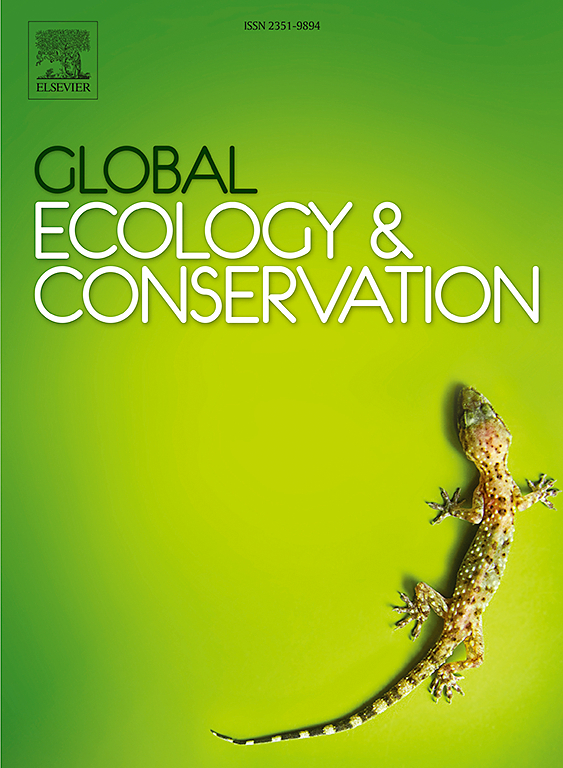在其核心地区监测极度濒危的巴尔干猞猁的十年:来自空间捕捉再捕获模型的见解
IF 3.5
2区 环境科学与生态学
Q1 BIODIVERSITY CONSERVATION
引用次数: 0
摘要
监测濒危物种的状况对于指导保护和管理措施至关重要,特别是对于面临隔离和数量少的种群。巴尔干猞猁(lynx lynx balcanicus)是欧亚猞猁中最濒危的亚种,在巴尔干西南部生存,只有不到50只成熟的个体。对于这种稀有、分布广泛、难以捉摸的物种来说,获得准确的种群估计是一项挑战。在长达十年的监测期内,我们使用了摄像机诱捕和空间捕获-再捕获(SCR)模型,首次提供了巴尔干猞猁在其核心地区、马夫罗沃国家公园及其周边地区的可靠密度估计。在5次会议中,我们记录了9439个摄像头陷阱夜的176次探测,每次会议最多识别10个个体。尽管重新捕获的猞猁数量很少,但我们的多时段分析显示,在过去十年中,猞猁的密度(SE)有所下降,从2013年每100 平方公里适宜栖息地2.3( ± 0.7)只猞猁下降到2023年的1.2( ± 0.4)只。我们比较了每次独立估计的密度或作为趋势,排除和不排除不适合的栖息地。这些发现为极度濒危的巴尔干猞猁提供了第一个可靠的密度估计,并证实了对人口状况的担忧。我们的研究结果强调了长期、系统监测人口密度变化的价值。虽然密度估计与欧洲其他猞猁种群相当,但观察到的下降,加上种群的遗传状况,突出了加强保护工作的迫切需要。本文章由计算机程序翻译,如有差异,请以英文原文为准。
A decade of monitoring the critically endangered Balkan lynx in its core area: Insights from spatial capture recapture models
Monitoring the status of endangered species is essential to guide conservation and management measures, especially for populations facing isolation and small numbers. The Balkan lynx (Lynx lynx balcanicus), the most endangered subspecies of the Eurasian lynx, survives in the southwestern Balkans with fewer than 50 mature individuals. Obtaining accurate population estimates is challenging for such a rare, wide ranging and elusive species. We used camera-trapping and Spatial Capture-Recapture (SCR) modelling to provide the first reliable density estimates of the Balkan lynx in its core area, Mavrovo National Park and surroundings, over a decade-long monitoring period. Across five sessions, we recorded 176 detections over 9439 realised camera trap nights, identifying up to 10 individuals per session. Despite a low number of recaptures, our multisession analyses reveal a decline in density (SE) over the past decade, from 2.3 ( ± 0.7) lynx per 100 km2 of suitable habitat in 2013 to 1.2 ( ± 0.4) in 2023. We compared densities estimated independently for each session or as a trend, with and without excluding unsuitable habitat. These findings provide the first robust density estimates for the critically endangered Balkan lynx and confirm concerns about the state of the population. Our results underscore the value of long-term, systematic monitoring to detect changes in population density. While density estimates are comparable to other lynx populations in Europe, the observed decline, combined with the genetic state of the population, highlights the urgent need for enhanced conservation efforts.
求助全文
通过发布文献求助,成功后即可免费获取论文全文。
去求助
来源期刊

Global Ecology and Conservation
Agricultural and Biological Sciences-Ecology, Evolution, Behavior and Systematics
CiteScore
8.10
自引率
5.00%
发文量
346
审稿时长
83 days
期刊介绍:
Global Ecology and Conservation is a peer-reviewed, open-access journal covering all sub-disciplines of ecological and conservation science: from theory to practice, from molecules to ecosystems, from regional to global. The fields covered include: organismal, population, community, and ecosystem ecology; physiological, evolutionary, and behavioral ecology; and conservation science.
 求助内容:
求助内容: 应助结果提醒方式:
应助结果提醒方式:


